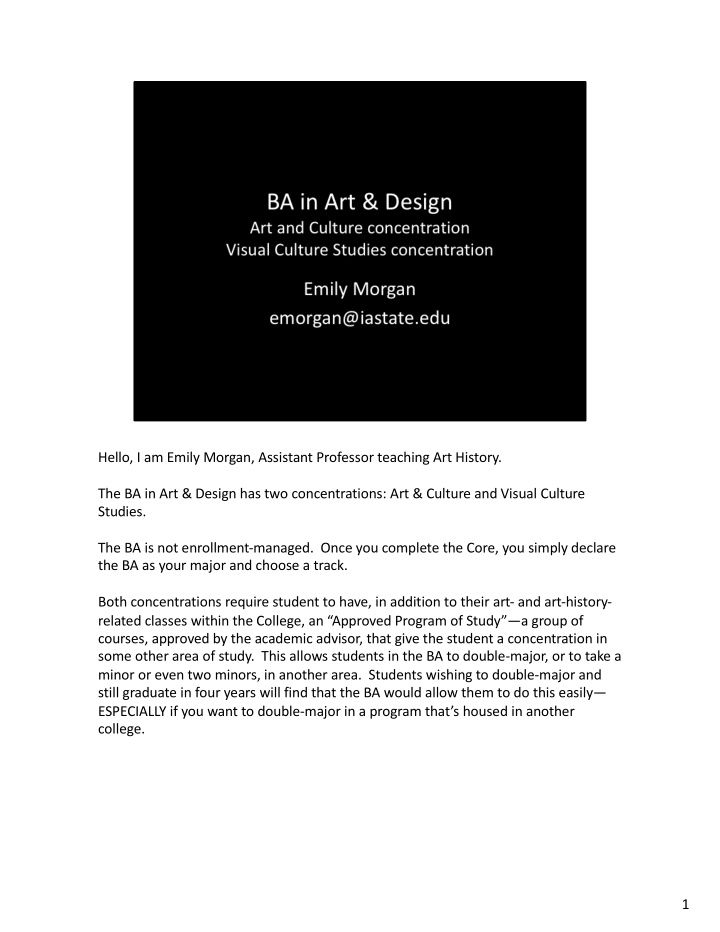



Hello, I am Emily Morgan, Assistant Professor teaching Art History. The BA in Art & Design has two concentrations: Art & Culture and Visual Culture Studies. The BA is not enrollment-managed. Once you complete the Core, you simply declare the BA as your major and choose a track. Both concentrations require student to have, in addition to their art- and art-history- related classes within the College, an “Approved Program of Study”—a group of courses, approved by the academic advisor, that give the student a concentration in some other area of study. This allows students in the BA to double-major, or to take a minor or even two minors, in another area. Students wishing to double-major and still graduate in four years will find that the BA would allow them to do this easily— ESPECIALLY if you want to double-major in a program that’s housed in another college. 1
This fellow understood better than most the power of art to convince people of just about anything. In order to “read” this painting and figure out what it’s trying to tell us, we have to have an understanding of art history. People like this guy WANTED you to look at the painting and just say “pretty!” and not understand what was going on because they wanted to manipulate viewers into believing certain things. An understanding of art history offers VISUAL LITERACY—which entails, in part, understanding what you’re looking at and knowing how you’re being manipulated by images. This is King Louis the 14 th of France. He was an absolute monarch, meaning there was no one in power other than him—no senate, no house, nothing. He had advisors but if he didn’t like their advice, he got rid of them and got new advisors. He understood very well the power of art to convey messages and he used it to legitimize his own power. He created the French Royal Academy of Art in the 1640s and all artists who were any good wanted to belong to it. It was the most widely respected school of art in France at the time and its leaders reported directly to the king. It had official exhibitions every two years and these were pretty much the only place you could see art. So basically the king controlled all art production in France. He made sure that art was produced that made him and his government look good and that promoted the kinds of morals and ideals that he approved of. 2
Here he wears a robe covered in the fleur-de-lis, the symbol of France. The fleur-de- lis is also all over everything around him—the throne, the footstool, everything. It makes it look like the power of France is radiating out from him and covering everything, like he is the center of all power. He was over 60 when this piece was painted but he looks much younger, and he’s shown with lovely long legs (that he was very proud of) and shoes with a high, red heel (he basically invented high heels, which only men wore at the time). The painting shows how powerful he is, and how elegant. And because he controlled art production, no one in his country ever saw any other images of him—they never saw him looking undignified, or with food in his teeth—so they never got any other idea of what he must be like. He used art to manipulate people. Studying art history helps us to understand how art has been used in the service of politics and social forces in the past and how it is STILL being used today. Studying art history leads to better visual literacy. 2
Image is John Singleton Copley’s painting of Paul Revere who was a metalsmith and a hero of the American Revolutionary War. In this painting done before the war, Copley shows Revere as a working man, in his shirtsleeves, not as an aristocrat. 3
Jean Honore Fragonard created this painting titled ‘The Swing’ in 1767. He was showing carefree people having fun in a fantasy garden. The colors are bright, the mood is light and take note that her shoe is in the air; who knows where it will land? 4
5
This degree track does not require the first-year Core. Students in this degree track take two classes in a foreign language and are often interested in pursuing museum work, a graduate degree in art history, or work as an art cataloguer. 6
The Art and Culture option provides a general studies degree in which students combine art with another area of interest. You create your own program of study, which can include another major or minor in a subject taught outside the College of Design. This concentration emphasizes studio components. 7
Understanding your past, knowing about art and poetry and literature, makes you a more interesting person. 8
9
10
11
12
Recommend
More recommend